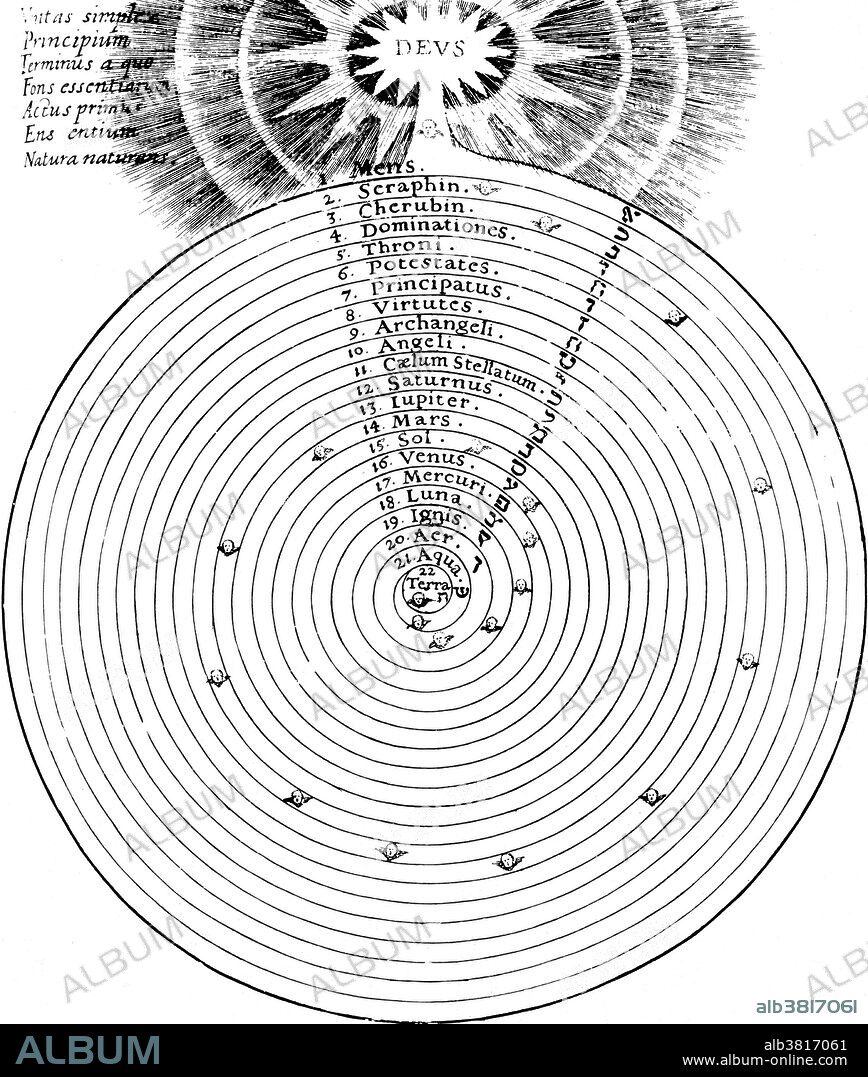alb3817061
Aristotlelian and Christian Cosmologies Merge

|
Añadir a otro lightbox |
|
Añadir a otro lightbox |



¿Ya tienes cuenta? Iniciar sesión
¿No tienes cuenta? Regístrate
Compra esta imagen.
Selecciona el uso:

Título:
Aristotlelian and Christian Cosmologies Merge
Descripción:
Traducción automática: Diagrama histórico que ilustra el injerto de la teoría aristotélica en la versión cristiana del cosmos. Aristóteles (384-322 aC) desarrolló un modelo temprano del cosmos basado en el concepto de movimiento circular uniforme. Para dar cuenta de los movimientos de las estrellas, el sol, la luna y los cinco planetas conocidos, su modelo utilizó 56 capas esféricas, cada una centrada en la tierra. Estas conchas se dividieron en dos regiones: el reino del cambio cerca de la tierra y los cielos eternamente inmutables. El reino del cambio constaba de esferas de cada uno de los cuatro elementos clásicos: tierra, agua, aire y fuego. Los cielos estaban hechos de un material transparente e inmutable llamado éter. Debido a la influencia de Alberto Magno y Tomás de Aquino, la cosmología de Aristóteles se convirtió en una parte integral de la fe católica. En el siglo XIII su primum mobile fue identificado con el mismo dios perdiendo así su valor astronómico en favor del razonamiento moral y religioso. El cosmos se pobló de figuras celestiales que intercedían entre el hombre y dios
Historical diagram illustrating the grafting of Aristotelian theory onto the Christian version of the cosmos. Aristotle (384-322 BC) developed an early model of the cosmos based on the concept of uniform circular motion. To account for the motions of the stars, sun, moon, and the five known planets, his model used 56 spherical shells each centered on the earth. These shells were divided into two regions: the realm of change near the earth and the eternally unchanging heavens. The realm of change consisted of spheres of each of the four classical elements: earth, water, air, and fire. The heavens were made of an unchangeable, transparent material called the ether. Due to the influence of Albertus Magnus and Thomas Aquinas Aristotle's cosmology became an integral part of the Catholic faith. In the 13th century his primum mobile was identified with god himself thus losing its astronomical value in favor of moral and religious reasoning. The cosmos were peopled with celestial figures who interceded between man and god.
Crédito:
Album / Science Source / New York Public Library
Autorizaciones:
Tamaño imagen:
3010 x 3549 px | 30.6 MB
Tamaño impresión:
25.5 x 30.0 cm | 10.0 x 11.8 in (300 dpi)
Palabras clave:
AGUA • AIRE • ARTE • ASTRONOMIA • ASTRONÓMICO • BLANCO Y NEGRO • CATOLICO • CIENCIA • COSMOLOGIA • COSMOLOGICO • COSMOS • CRISTIANO • CUERPO CELESTE • DIAGRAMA • DIBUJO • ESFERA • FE • HISTORIA • HISTORICO • ILUSTRACION • IMPORTANTE • INJERTO • JUPITER • LUNA • MARTE • OBJETO CELESTE • OBRA DE ARTE • PLANETA TIERRA • QUERUBINES • RELIGION • RELIGIOSO • SATURNO • SERAFIN • SOL • TAPON (HORTICULTURA) • TEORIA • TOMÁS DE AQUINO • VENUS • VIRTUDES
 Pinterest
Pinterest Twitter
Twitter Facebook
Facebook Copiar enlace
Copiar enlace Email
Email
